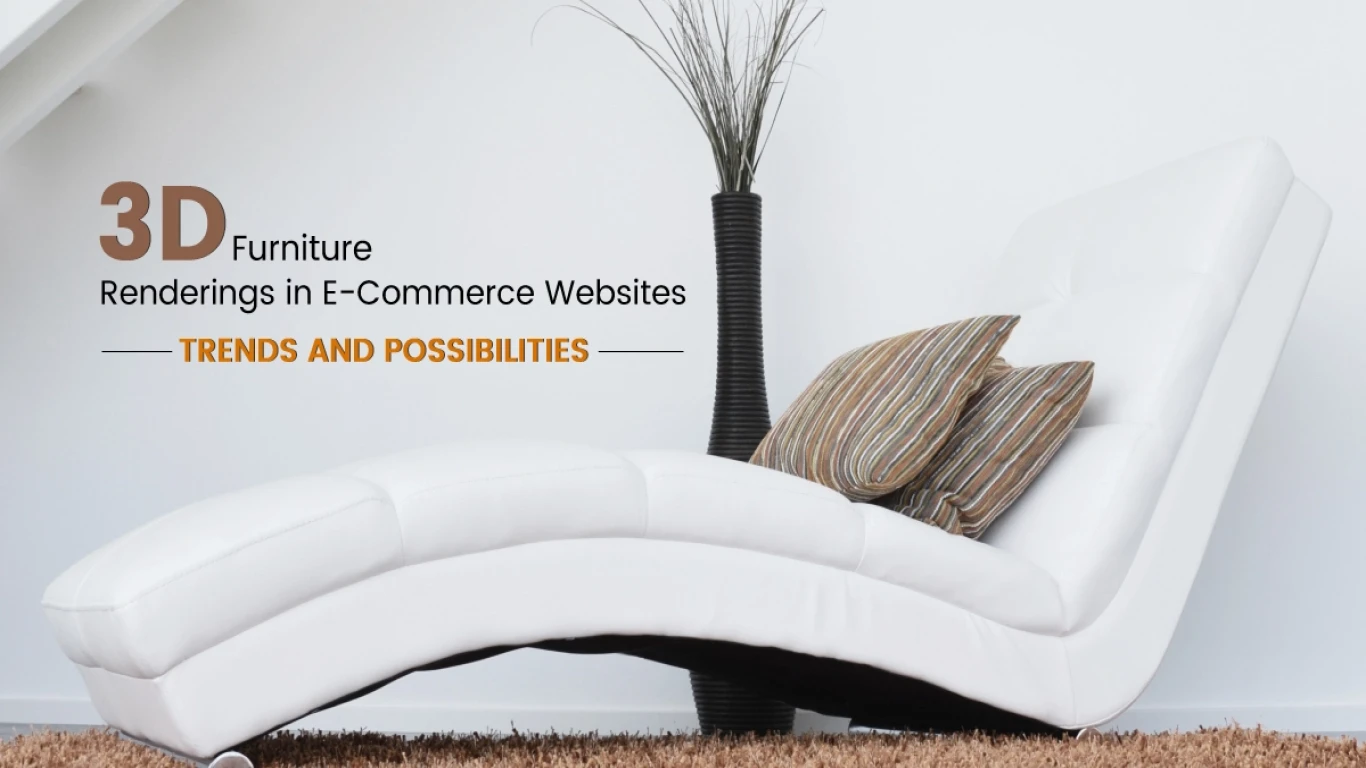3D Furniture Renderings in E-Commerce: Trends and Possibilities
by Delwar Hussain / Last Update: September 18, 2023
In the fast-paced world of e-commerce, where online shoppers are increasingly relying on digital experiences to make purchasing decisions, the role of visuals has become paramount. One area that has witnessed remarkable advancements is the integration of 3D furniture renderings in e-commerce websites. By harnessing the power of 3D technology, furniture businesses can revolutionize the way customers interact with their products, providing an immersive and engaging online shopping experience.
3D Furniture Renderings in E-Commerce Websites have emerged as a game-changer, allowing customers to visualize furniture items with unprecedented realism and detail, all from the comfort of their homes. Gone are the days of relying solely on flat images or physical samples to make informed choices. With 3D visualizations and renderings, customers can now explore furniture designs from every angle, assess intricate details, and even virtually place products within their living spaces.
The furniture industry, like many others, has undergone a significant digital transformation. The traditional design process, involving physical prototypes and lengthy iterations, can now be streamlined and accelerated with the help of 3D modeling and rendering. Product designers and manufacturers can create lifelike representations of their furniture items, empowering them to visualize, refine, and perfect their designs before they hit production.
Moreover, from a marketing perspective, 3D furniture renderings have become an indispensable tool for businesses aiming to stand out in the competitive e-commerce landscape. By incorporating stunning 3D products and interactive visual experiences into their websites, furniture retailers can elevate their brand presence and provide a differentiated online shopping experience for their customers.
In the following sections, we will delve deeper into the benefits, current trends, implementation strategies, and future possibilities of 3D furniture renderings in e-commerce. We will explore how this technology enhances customer experience, boosts sales, and revolutionizes the way the furniture industry operates. So, fasten your seatbelts as we embark on a journey to uncover the incredible world of 3D furniture renderings in e-commerce websites.
Benefits of 3D Furniture Renderings in E-Commerce
The incorporation of 3D furniture renderings in e-commerce websites brings forth a multitude of benefits for both businesses and customers alike. Let’s explore the advantages of leveraging this technology:
- Enhanced Customer Experience: With 3D renderings, online shoppers can engage in a highly interactive and immersive experience. They can rotate, zoom, and examine furniture items from various angles, gaining a comprehensive understanding of their design, texture, and dimensions. This level of visual detail enables customers to make more informed purchase decisions, resulting in higher satisfaction and reduced return rates.
- Increased Sales and Conversion Rates: By providing a rich and dynamic visualization of their products, furniture retailers can capture the attention and interest of potential customers more effectively. The ability to showcase furniture items in a realistic manner helps bridge the gap between online browsing and the tactile experience of physical stores. Studies have shown that incorporating 3D renderings in e-commerce can lead to significant boosts in conversion rates and overall sales.
- Cost and Time Savings for Manufacturers and Retailers: Traditional furniture photography and staging can be time-consuming and costly. 3D furniture renderings offer a cost-effective alternative, eliminating the need for physical setups and extensive photo shoots. Additionally, the flexibility of 3D models allows for easy modifications and updates, reducing the time required to create marketing materials for new products or design variations.
- Improved Customization Options: Personalization is a growing trend in the e-commerce industry. With 3D furniture renderings, customers can customize furniture items in real-time, exploring different finishes, colors, fabrics, and configurations. This level of customization empowers customers to create unique pieces that suit their specific preferences and needs, fostering a deeper sense of ownership and satisfaction.
The integration of 3D furniture renderings in e-commerce websites not only enhances the overall shopping experience but also offers tangible benefits to businesses. From increased sales and conversion rates to cost savings and improved customization options, this technology has proven to be a valuable asset in the ever-evolving landscape of online furniture shopping. Embracing 3D renderings can give furniture manufacturers and retailers a competitive edge in the digital marketplace, catering to the demands of modern consumers who seek immersive and engaging e-commerce experiences.
Current Trends in 3D Furniture Renderings
The field of 3D furniture renderings in e-commerce is constantly evolving, driven by advancements in technology and changing consumer expectations. Let’s explore some of the current trends that are shaping the industry:
- Photorealistic Renderings: The pursuit of realism is at the forefront of 3D furniture renderings. Through advanced rendering techniques, such as global illumination and ray tracing, designers can achieve stunning levels of photorealism. The use of high-quality textures, accurate lighting, and intricate details ensures that the rendered furniture items closely resemble their real-world counterparts.
- Interactive 3D Product Views: Static images are being replaced by interactive 3D product views, allowing customers to actively engage with furniture items. These interactive experiences enable users to rotate, zoom in/out, and explore the product from different angles. By providing a dynamic and hands-on experience, furniture retailers can enhance customer engagement and create a deeper connection between shoppers and their products.
- Augmented Reality (AR) Integration: AR technology has revolutionized the way customers envision furniture in their own spaces. By leveraging AR, e-commerce websites can offer virtual try-on experiences, where customers can superimpose 3D furniture models into their rooms using their mobile devices. This interactive and immersive experience enables customers to visualize how the furniture will look and fit within their existing decor, reducing uncertainty and improving purchase confidence.
- Virtual Reality (VR) Experiences: Virtual reality has the potential to transport customers into virtual showrooms or immersive environments where they can explore and interact with 3D furniture items in a highly realistic and engaging manner. VR technology opens up new possibilities for creating captivating and memorable shopping experiences, allowing customers to virtually walk through virtual stores and make informed decisions.
- Personalization and Customization Features: Today’s consumers seek personalized experiences. 3D furniture renderings enable furniture retailers to offer customization options, allowing customers to tailor products to their specific preferences. From selecting finishes, fabrics, and colors to adjusting dimensions and configurations, customers can actively participate in the design process, creating truly unique pieces that reflect their personal style.
By staying abreast of these current trends, furniture manufacturers and retailers can leverage the power of 3D furniture renderings to create compelling and engaging e-commerce experiences. Whether through photorealistic renderings, interactive views, AR integration, VR experiences, or customization features, embracing these trends allows businesses to cater to the evolving demands of online shoppers, ultimately driving sales and customer satisfaction.
Implementation of 3D Furniture Renderings in E-Commerce
Implementing 3D furniture renderings in e-commerce requires careful consideration and collaboration between various stakeholders. Let’s explore the key steps involved in successfully integrating 3D furniture renderings into e-commerce websites:
1. Creating 3D Models
- The role of CAD software in 3D modeling: Computer-aided design (CAD) software plays a crucial role in creating accurate and detailed 3D models of furniture items. Designers and 3D artists utilize CAD tools to bring their concepts to life, ensuring precise measurements, proportions, and aesthetics.
- Hiring 3D artists and designers: Skilled 3D artists and designers with expertise in furniture modeling are essential for creating high-quality 3D furniture renderings. They possess the necessary knowledge of 3D software, textures, lighting, and materials to accurately represent the furniture items.
- Utilizing photogrammetry for realistic renderings: Photogrammetry is a technique that involves capturing real-world objects from multiple photographs to create accurate 3D models. This approach can be utilized to scan and recreate existing furniture items, allowing for highly realistic renderings.
2. Integrating 3D Models into E-Commerce Websites
- Optimizing 3D assets for web use: To ensure smooth loading and optimal performance on e-commerce websites, 3D assets need to be optimized. This involves reducing file sizes, optimizing textures, and employing compression techniques without compromising visual quality.
- Choosing the right file formats: Selecting suitable file formats is crucial for compatibility and rendering quality. Commonly used formats for 3D furniture renderings include FBX, OBJ, and glTF/glb. Compatibility with different platforms and devices should be taken into consideration.
- Collaborating with web developers for seamless integration: Working closely with web developers is essential to seamlessly integrate 3D furniture renderings into the e-commerce website. Developers can implement the necessary code, frameworks, and libraries to ensure smooth rendering and interactive functionalities.
3. Supporting Technologies for 3D Renderings
- AR and VR technologies: Augmented reality (AR) and virtual reality (VR) technologies provide unique opportunities to enhance the customer experience with 3D furniture renderings. Integrating AR/VR capabilities into e-commerce websites requires the adoption of suitable software development kits (SDKs) and frameworks.
- WebGL and real-time rendering: WebGL, a web standard for rendering 3D graphics, enables interactive and real-time experiences in the browser. Leveraging WebGL technologies, such as Three.js or Babylon.js, allows for seamless and high-performance rendering of 3D furniture models.
- Cloud-based rendering solutions: Rendering complex 3D models can be resource-intensive. Cloud-based rendering solutions offer scalability and computational power to handle the rendering process efficiently. Leveraging cloud infrastructure can speed up rendering times and ensure smooth performance.
By following these implementation steps and leveraging supporting technologies, furniture businesses can successfully integrate 3D furniture renderings into their e-commerce websites. This opens up a world of possibilities for delivering immersive and engaging experiences to online shoppers, ultimately driving sales and establishing a competitive edge in the furniture industry.
Future Possibilities of 3D Furniture Renderings in E-Commerce
The future of 3D furniture renderings in e-commerce holds immense potential for innovation and transformative experiences. Let’s explore some exciting possibilities that lie ahead:
- Advanced Augmented Reality (AR) Experiences: As AR technology continues to evolve, we can expect more sophisticated and seamless integration of 3D furniture renderings into the real world. Imagine customers being able to virtually place and interact with furniture items in their own homes, visualizing how they fit and complement their existing decor in real-time.
- Artificial Intelligence (AI) and Personalized Recommendations: AI algorithms can analyze customer preferences, styles, and browsing behavior to offer highly personalized recommendations for furniture items. Coupled with 3D furniture renderings, AI-powered systems can provide realistic visualizations of recommended products within the customer’s virtual space, enhancing the shopping experience and driving customer satisfaction.
- Social Media Integration: Integration of 3D furniture renderings with social media platforms can empower users to explore and visualize furniture items within their social feeds. Users can virtually try out furniture pieces shared by influencers or friends, fostering social engagement and driving interest in the showcased products.
- Collaborative Design and Co-creation: The future may bring collaborative design platforms where customers can actively participate in the design process. Leveraging 3D furniture renderings, customers can customize and co-create furniture items with designers or manufacturers, ensuring a truly unique and personalized product.
- Expanded Virtual Showroom Experiences: Virtual showrooms can be enhanced with 3D furniture renderings, offering immersive and realistic environments where customers can virtually browse and interact with an extensive range of furniture items. Interactive elements, such as real-time customization, virtual sales assistants, and guided tours, can further elevate the virtual showroom experience.
- Integration with Smart Home Technology: The integration of 3D furniture renderings with smart home technology can enable customers to envision how furniture items fit into their connected living spaces. For instance, customers can see how a smart sofa integrates with other IoT devices or how a dining table accommodates smart lighting solutions.
- Advancements in Haptic Feedback: Haptic feedback technology, which provides a sense of touch and texture, holds potential for enhancing the realism of 3D furniture renderings. Future developments may enable customers to virtually feel the texture, comfort, and quality of furniture items, bridging the gap between the physical and digital worlds.
As technology continues to evolve and user expectations evolve, the possibilities for 3D furniture renderings in e-commerce are vast. Embracing these future possibilities can revolutionize the way customers shop for furniture online, offering them highly personalized, interactive, and immersive experiences that seamlessly blend the digital and physical realms.
Challenges and Limitations of 3D Furniture Renderings
While 3D furniture renderings in e-commerce offer numerous benefits and exciting possibilities, there are also several challenges and limitations to consider. Let’s explore some of these challenges:
- Technical Requirements and Infrastructure: Implementing and maintaining the necessary technical infrastructure to support 3D furniture renderings can be complex and resource-intensive. High-performance servers, optimized rendering pipelines, and sufficient bandwidth are required to ensure smooth and fast loading of 3D models on e-commerce websites.
- Cost and Expertise: Creating high-quality 3D furniture renderings often requires specialized skills and software expertise. Hiring or training 3D artists and designers can be costly, especially for smaller furniture businesses. Additionally, investing in advanced software licenses and hardware can add to the overall expenses.
- Consistency and Accuracy: Achieving consistent and accurate representations of furniture items across different devices, browsers, and screen resolutions can be challenging. Ensuring that the 3D renderings accurately reflect the actual physical products in terms of color, texture, and proportions is crucial for building customer trust and avoiding potential dissatisfaction.
- File Size and Loading Times: 3D models can have larger file sizes compared to traditional 2D images, leading to longer loading times for e-commerce websites. Optimizing file sizes without compromising visual quality is essential to provide a seamless user experience. Slow loading times can deter potential customers and negatively impact conversion rates.
- Compatibility and User Experience: 3D furniture renderings heavily rely on web technologies and device capabilities. Ensuring compatibility across different browsers, operating systems, and mobile devices is critical to reaching a wide audience. However, limitations in device capabilities or outdated software can affect the rendering quality and overall user experience.
- Integration Challenges: Integrating 3D furniture renderings into existing e-commerce platforms and content management systems may pose technical challenges. It requires collaboration between designers, developers, and platform providers to ensure proper integration, customization options, and seamless functionality.
- Product Complexity and Scalability: Some furniture items, such as modular or customizable pieces, can be inherently complex to represent accurately in 3D renderings. Ensuring that all possible configurations, variations, and customization options are accurately reflected in the 3D models can be a significant challenge. Additionally, scaling the production of high-quality 3D renderings for a large catalog of furniture items can be time-consuming and resource-intensive.
Despite these challenges and limitations, advancements in technology, increased accessibility, and growing consumer demand are driving the adoption of 3D furniture renderings in e-commerce. By carefully addressing these challenges and leveraging best practices, furniture businesses can overcome the limitations and reap the benefits of this transformative technology.
Conclusion
3D furniture renderings have emerged as a powerful tool in the world of e-commerce, revolutionizing the way furniture items are showcased, experienced, and purchased online. This article has explored the trends, possibilities, challenges, and implementation strategies surrounding 3D furniture renderings in e-commerce websites.
The use of photorealistic renderings, interactive 3D product views, augmented reality (AR) integration, virtual reality (VR) experiences, and customization features has transformed the customer experience and enhanced user engagement. These advancements have allowed online shoppers to visualize furniture items in a realistic and immersive manner, bridging the gap between the digital and physical worlds.
While the future of 3D furniture renderings holds tremendous potential, there are challenges to navigate. Technical requirements, cost, consistency, loading times, compatibility, integration, and scalability pose hurdles that need to be addressed for successful implementation. However, with the rapid advancements in technology, these challenges can be overcome through careful planning, collaboration, and leveraging supporting technologies.
As furniture businesses strive to stay competitive in the ever-evolving e-commerce landscape, embracing the possibilities of 3D furniture renderings is essential. By providing customers with personalized, interactive, and visually rich experiences, businesses can drive customer satisfaction, increase conversion rates, and establish a strong online presence.
In conclusion, 3D furniture renderings in e-commerce offer immense potential for transforming the way customers shop for furniture online. By staying attuned to current trends, addressing challenges, and exploring future possibilities, furniture manufacturers and retailers can unlock new avenues for growth, innovation, and delivering exceptional customer experiences in the digital realm.
Article by
Delwar Hussain
Image Processing Expert, Photography Enthusiast, Blogger, COO at Cutting Edger
Over 18 years of experience in Graphic Design, Image Editing, 3D Modeling/Rendering and Digital Products, I have got opportunity to work with different local and multi-national companies, among of them GraphicPeople, Modern Herbal Group and British Broad Casting (BBC) can be highlighted. During my career I have worked with Coca-Cola, Turkish Airlines, Singapore British American Tobacco, Dell, Pfizer Pharmaceuticals, Indeed.com, International Hotel Group (IHG), Santander Bank, Quad Inc. Adidas, Nike, Dove etc. Having 18 years of experience and being a Co-Founder and COO of Cutting Edger is providing Post Production Image Editing, 3D Modeling and Rendering, Desktop Publishing and Digital Products like Web Design and Development, Software Development, etc.

